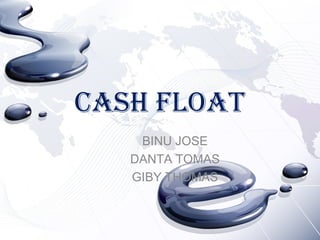
Cash float
- 1. CASH FLOAT BINU JOSE DANTA TOMAS GIBY THOMAS
- 2. CONTENTS • Concept of Cash Float • Different types or components of float • Management of Cash Float
- 3. What is Float? • Bankers define floats as cash obligation that are in the process of collection. • In simple words, Float is the difference between the cash balance appear in the passbook and that appear in the firm’s book.
- 4. COmpONENTS/TypES OF FLOAT FLOAT – Difference between cash and bank records on account of non clearing of cheques. NEGATIVE FLOAT - POSITIVE FLOAT – Related to Bills Receivable Related to Bills Payable. Collection Float Disbursement /Payment Float • Invoicing Float •Mail Float •Mail Float • Processing Float • Processing Float •Collection Float •Collection Float
- 5. Negative Float-Collection Float • It occurs when the firm receive payments. • It is undesirable for a firm and it should be minimized. • Collection float is the time which elapses between the time a payer deduct a payment from its accounts ledger and the time when the payee actually receives the funds in actual form. Collection Float = Invoicing Float + Mail Float+ Processing Float+ Clearing Float
- 6. Four types of Collection Float 1.Invoicing Float • Invoicing float is the time it takes for a firm to bill receivables. The efficiency of the The efficiency of the Effect of company’s internal company’s internal Invoicing accounting and accounting and Float billing procedures billing procedures
- 7. 2. Mail Float Mail Float is the time the firm’s bill spends in the mail on its way to the customer and the time the customer’s cheque spend in the mail on its way to the firm. Bill Firm Customer Cheque
- 8. 3.Processing Float When the firm’s office get the cheque and if the office machinery is lax, the cheque is deposited with the bank not on the same day but the next day. It is the time between a firm’s receipt of a payment and It is the time between a firm’s receipt of a payment and its deposit of the cheque for collection its deposit of the cheque for collection
- 9. 4. Clearing Float • It is the time from when the bank accept a cheque for deposit to when it makes the funds available in the firms account Bank Firm
- 10. Collection Float Customer Mail the cheque Mail Float Company receive the cheque Processing Float Company deposits the cheque Clearing Float Bank process and clear the cheque
- 11. Positive Float- Disbursement /payment Float • Positive Float occurs when the firm makes the payment • It allow the firm to maintain a control over the cash for a long period of time. Disbursement Float is the time between when a firm writes a cheque on available bank account fund and when the bank deduct the corresponding amount from the bank balance. Delay in Time for Supplier- Cash Firm – Credited to his disbursement of Issue Cheque cash bank account
- 12. Disbursement/Payment Float Company Mail the cheque to Supplier Mail Float Supplier receive the cheque Processing Float Supplier deposits the cheque Clearing Float Bank process and credits Supplier's account
- 13. Net Float • Difference between Payment Float and Receipt Float Net Float= Disbursement Float - Collection Float
- 14. Management of Float 1. Speeding Up Collection • The collection time comprises mailing time, Cheque processing delay, and the bank's availability delay. • The time lag in collection of receivables can be considerably reduced by managing the time taken by postal intermediaries and banks. For this purpose the company may also use lockboxes and centralisation banking system.
- 15. Lock Boxes system • Under a lock box system, customers are advised to mail their payments to special post office boxes called lockboxes, which are attended to by local collection banks, instead of sending them to corporate headquarters. • The local bank collects the Cheque from the lock box once or more a day, deposits the Cheque directly into the local bank account of the firm, and furnishes details to the firm.
- 16. Concentration Banking • A firm may open collection centres (banks) in different parts of the country to save the postal delays. • Under this system, the collection centres are opened as near to the debtors as possible, hence reducing the time in dispatch, collection etc.
- 17. 2. Delaying Payment • Payable centralization • Payable through Draft • Controlled Disbursement Accounts • Zero Balanced account:- A firm does not keep any cash balance in the bank account. Cash is transferred only when the cheque is presented for the payment to the bank.
- 18. Thank you!